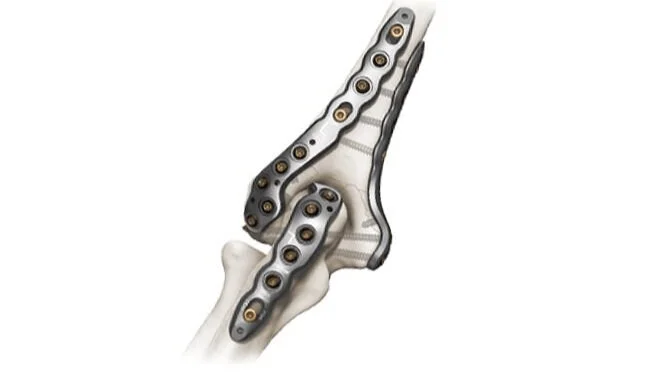Elbow Fracture Fixation.
Why might I need elbow fracture fixation?
Not everyone with a fractured elbow needs surgical fixation. If possible, Mr Moverley will treat your fracture with non-operative treatments, like pain medicines, physiotherapy, and slings.
You may benefit from elbow fracture surgery in the following scenarios:
Dislocated fractures, in which one of the bones of the elbow has dislocated from the joint.
Open fractures, in which the bone penetrates the skin.
Injuries to surrounding blood vessels and nerves.
Widely displaced fractures
Displaced fractures involving the joint surfaces disrupting the cartilage of the joint
In these cases, fixation can realign your bones back into their proper configuration. This significantly increases the chance that your bone will heal properly and may be associated with improved long-term function.
What does surgery involve?
On the day of surgery you will be admitted to the ward or surgical admission area. You will once again meet Mr Moverley who will ensure you are still happy to proceed and that you understand the risks and benefits of the procedure. This is a good opportunity for you to ask any further questions. You will be asked to sign a consent form if you have not already done so.
You will meet your anaesthetist who will explain the type of anaesthetic you will receive. Most elbow fracture surgery requires a general anaesthetic (you will be asleep) and a nerve block so that the arm will be numb for approximately 12 hours post operatively.
Elbow fractures are extremely complex and the specific techniques employed by Mr Moverley will depend on the exact fracture configuration. The ultimate goal is that the normal elbow anatomy and stability is restored as closely as possible.
Broadly speaking the techniques that may be employed fall into the following categories:
Strong suture fixation – In simple fractures involving the olecranon process (the point of the elbow) it is possible to repair the fracture using stitch material alone. This technique has the advantage of avoiding problem caused but placing bulky or sharp metalwork just underneath the skin.
Plate & Screw fixation – Specifically contoured plates allow the surgical reconstruction of complex fractures involving any of the bones of the elbow. Because the bones of the elbow lie just below the skin the plates can cause irritation and may require subsequent removal.
Arthroplasty (Replacement) – If the bones are broken into too many pieces to reconstruct is may be necessary to replace them with a metal implant that matches the shape of the bone. This is most commonly performed for radial head or distal humerus fractures.
Surgery is performed through an open incision on the back or side of the elbow. The length of the scar will depend on your fracture configuration but 10-20cm is typical.
The wounds are repaired with stitches and covered with a splash proof dressing. The wounds should be kept dry for 10-14 days.
What happens post operatively?
Immediately after surgery your arm will be in a sling. You will be given painkillers if you are in any pain, and these will also be provided upon discharge.
A physiotherapist will assess you to make sure that you can remove and apply the sling safely. They will provide some early exercises to help prevent stiffness of the hand, wrist and elbow.
How long is the rehabilitation process?
A sling will be provided to rest the elbow but this should usually only be used for the first week or two after surgery. Early elbow movement is encouraged to prevent stiffness.
Physiotherapy is individualised to your specific injury and needs and will progress with the following goals:
Early (1-2 weeks): Minimize post-operative stiffness with active finger, wrist and elbow movements.
Middle (2-6 weeks): Continue to progress towards full active range of movement
Late (6-12 weeks and beyond): Strengthening program, once full range has been achieved. Graded return to all previous functional and recreation activities after 12 weeks.
Approximately how long will it be before I can…?
Drive 6 weeks
Desk job 2 weeks
Manual work 12-16 weeks
Golf 12 weeks
Racket sport 16 weeks
Contact sport 6 months
Repetitive overhead activity/sport 16 weeks
These are approximate and Mr Moverley will give you more specific advice following the procedure.
What are the potential risks and complications?
As with any operation, a small number of people may have problems after proximal humerus fracture fixation. Most of these problems are quite minor and can be treated easily but in approximately 5% of cases, further surgery is needed.
The main risks are:
Infection (1-2% of cases)
Major bleeding
Nerve injury
Elbow stiffness
Additional bone formation (Heterotopic ossification)
Numbness around the surgical scar
Symptomatic metal-work requiring removal (5-10% of cases)
Is elbow fracture fixation always successful?
Elbow fracture fixation leads to a healed bone in over 95% of cases. The overall complication rate is approximately 5-10%. While these statistics are encouraging, the results of elbow fracture fixation are therefore not guaranteed which is why Mr Moverley will want to discuss possible non-operative measures with you before proceeding.

